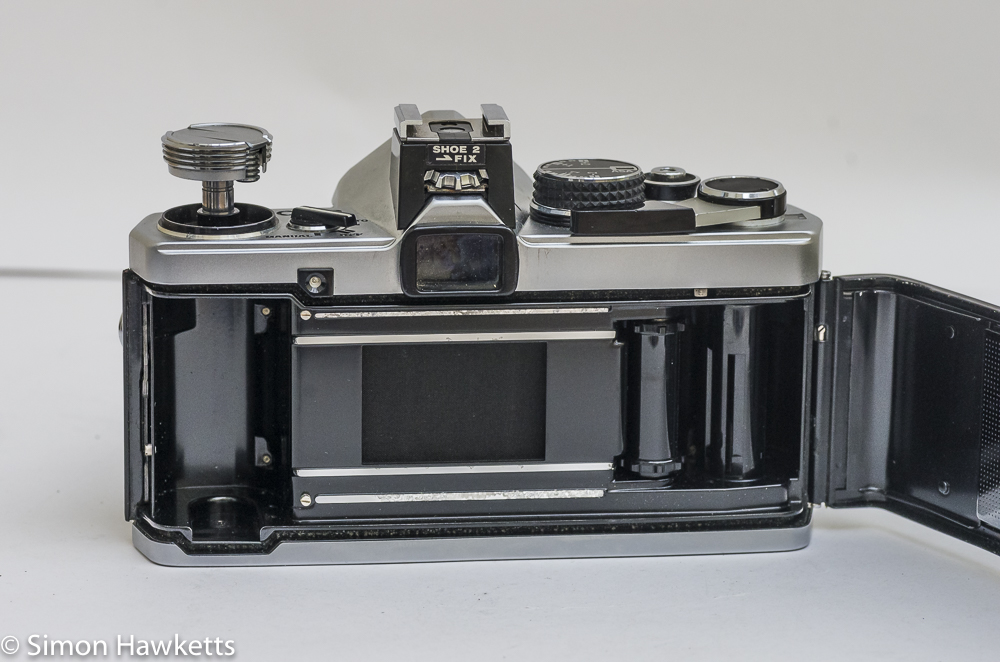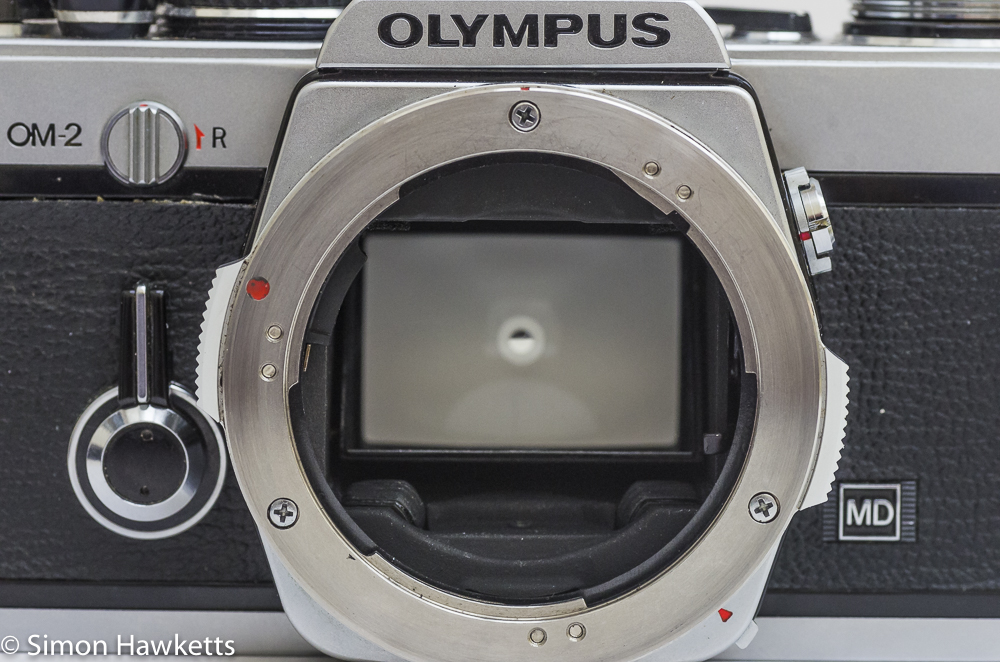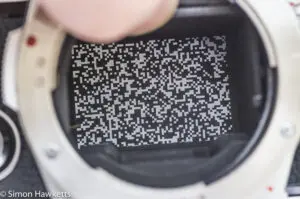Olympus OM-2 SLR camera review
This is my review and impressions of a camera I first wanted to buy about 40 years ago when I started work and wanted to get myself a ‘good’ camera. Unfortunately at the time I couldn’t afford it, but now I’ve managed to pick one up for a fraction of what it would have cost me then, so I finally own – an Olympus OM-2.
Olympus OM-2 Images









Pictures taken with this camera can be viewed here.
My Olympus OM-2 Camera
I managed to get this camera for a few pence under £16 from an eBay ‘spares or repair’ auction. The seller described it as very good condition, but the shutter was locked up and so it was sold as faulty. Now, I have no experience of the OM-2, but I thought that most cameras with locked shutters are just dirty or need batteries, so I would risk a few pounds. With just a few seconds to go in the auction I bid £15.93 and that is what I paid for it. When I looked at the bid history later, the next nearest bid was £15, so I’m glad I added the extra pence.
When the camera arrived a couple of days later, I discovered that it was supplied in its original Olympus box, with the handbook and the original strap and there was also a silver chain which clips on the strap lugs – were they originally supplied? I’m not sure.
Anyway, I took the body out (there was no lens supplied) and took off the body cap and found that the mirror was flipped up and so the viewfinder was blank. I tried the film advance and the shutter release, and they were both locked, so I checked to see if there were any batteries fitted. There were no batteries, so I fitted a couple of SR44’s and turned the main switch to ‘Manual’ and tried again – no luck; it wasn’t going to be that easy!
So I took the bottom cover off and used a pair of tweezers to slightly move some levers under the cover around the bottom of the mirror box, and suddenly there was a click and the mirror was down. (I later found I could just use the ‘reset’ function to do the same thing!). With the mirror down and the camera turned on, I could see that the needle in the viewfinder was responding to light, so I assumed the meter was working. I also found that the ‘check’ position on the main switch was causing the check LED to light, so I could see the battery circuit was OK.
I tried the shutter release, and it still wasn’t doing anything, and the film advance was still locked, so I had another poke around under the bottom cover, only this time at the end by the film advance. I can’t actually say what I did, but there was a click and the film advance started to move, and I found I could advance the film. When I clicked the shutter release, the shutter fired and that was it – the camera was working again.
There was a large black mark in the viewfinder, which was annoying until I remembered that the focus screen is replaceable on the OM-2. A quick release of the screen and a puff of air soon had that fixed.
I’ve given the camera a once over and as far as I can see, nearly everything seems to be fine with it. It really is in good physical cosmetic condition with no marks or scratches anywhere and even the black paintwork is without blemishes. The only sign that it’s not a new camera is the covering which is peeling from the top above the self-timers. When I opened the film compartment, the grey card (which was used when demoing the camera light meter) was still fitted, so I even wonder if it was new stock that was simply never sold.
The reason I used ‘nearly’ in the paragraph above is because there is an imperfection with the prism, but fortunately this is below the line of vision. If you look to the bottom of the viewfinder, there are a series of lines and marks, but fortunately they don’t interfere with composing the picture or the meter display.
Olympus OM-2 Description
The OM-2 is a manual focus 35 mm SLR which can be used in fully manual mode when it offers match needle metering, or Aperture Priority auto exposure mode. It was the second camera in the OM series, which Olympus launched at the start of the 1970s and revolutionized 35 mm camera design. Cameras went from being large pieces of kit that you carried around in big bags, to small units you throw in a bag or the back of the car. I remember being astounded when I first saw the OM-1 at how tiny it was.
Metering and Viewfinder
The other things I remember about the OM-2 when it first came out were the metering accuracy and the viewfinder.
The metering in the OM-2 was reputed to be the best in the world, although I can’t now remember if the reputation was real or something I read in a marketing or advertising brochure. I certainly remember reading how the light sensors measured the light reflected off the surface of the film during exposure and I notice that the shutter curtain when the shutter is cocked is a white and black pattern which presumably represents a 17% grey to get an accurate reading just before the exposure is made.
I remember the viewfinder was supposed to be one of the biggest and brightest around, and I can certainly confirm that on my version it is very bright. Certainly brighter than a Pentax Program A and a Minolta XG-M I happened to have on my desk at the time I did the comparison.
I think one of the nicest aspects of the viewfinder is the way the metering display changes as the camera switches from Manual Mode to Auto mode. On Manual mode, the display in the bottom left-hand side is a simple match needle +/- display. Either the shutter speed or aperture controls will alter the position of the needle, so the photographer just chooses a combination which gets the needle to the mid-position. Unfortunately, in Manual mode, there is no indication in the viewfinder as to the shutter speed or aperture the camera is set to.
When Auto mode is selected, the +/- display slides out of view and is replaced with a scale showing the shutter speed which the camera will use. In this mode, the OM-2 sets the shutter speed to the precise value it needs to get the correct exposure for the selected aperture.
One thing which is missing is any sort of indication that exposure compensation is applied. I believe this was fixed in the OM-2n model, where another indicator to show that compensation is being applied slides in under the exposure control as the compensation dial is turned.
OM-2 Control Layout.
The control layout of the OM-2 is a little different from most cameras which were produced in the mid to late 1970s.
Instead of having the shutter speed dial on the top plate, it is situated at the back of the lens mount. The position where a shutter speed dial would normally be placed is instead taken up by a large exposure compensation dial, which also doubles as the film speed dial for the light meter.
This layout is good to use if you don’t often apply exposure compensation because it’s as easy to adjust the shutter speed as it is to set the aperture. This makes the layout better suited to manual exposure shooters in my view, because applying exposure compensation is tricky to do with the camera held to the eye. It may be however that I’m looking at it too much as a user of a modern digital camera where you expect to adjust everything with the camera to your eye – back in the day this was probably not so.
The other nice touch I like with the layout is the switch which controls the flash sync socket. It’s shaped to fit around the socket itself and really epitomizes the whole philosophy of the OM series design – keep everything required but make it as small and functional as possible.
Overall Impressions
Although the OM-2 is a camera which is now 40 years old, I find it looks as modern and stylish as the day I first saw one (well an OM-1) all those years ago. In fact, when I handled this camera I was surprised at how basic it is – match needle metering on manual, simple needle display of shutter speed, no indicator of shutter speed or exposure compensation in the viewfinder. In my memory, this was such an advanced camera that it was a bit of a bump to be brought down to earth about how basic it is.
That doesn’t detract from how much I’m looking forward to loading up a film and trying the OM-2 out, though. I’m expecting great things!
Update: Problems with my OM-2
Just after I finished writing this piece, I had a problem with my OM-2.
The film advance would not latch after the shutter was cocked, so I could carry on winding the film, although I hadn’t fired the shutter. Unfortunately, this happened when we were away from home, and I was hoping to run a test film through the camera.
Because I was away and didn’t have any tools with me, I had to leave my test roll for another day, but once I got home I took the bottom off the camera and after a lot of messing about and the camera working and then not working again I eventually found the problem. Caught within the wind mechanism was a tiny piece of wire with plastic insulation on. It was only about a quarter of an inch long, but it was stopping the latch which stops the film advance when the shutter is cocked. Once I’d removed it, everything was back to normal.
I don’t know if this piece of wire has been in the camera since new, or if another owner had dropped it in there, but as far as I can tell it doesn’t originate from the OM-2 and everything seems to be working properly now it’s removed.
Olympus OM-2 Specification
- Olympus OM-2 35mm slr camera
- Manual or Aperture Priority auto exposure modes
- Shutter speed 1 sec to 1/1000 in manual, 60 sec to 1/1000 in auto
- Off-the-film-plane TTL metering
- Large bright viewfinder with alternate metering display for manual and auto
- Very small body
- X & F flash sync
- Removable hot shoe adapter
- Shutter speed dial at back of lens mount
- +/- 2 stops exposure compensation
- Self timer approx 10 sec
- Requires 2 x SR44 battery
- Motor drive available
- Handbook available here
Discover more from Everything Vintage
Subscribe to get the latest posts sent to your email.







I have O2 70s era along with accessories,lenses,flash,handbooks,cases,tripods,etc,mint condition.can supply photos and full details to anyone interested.